|
Welcome to the STEREO Learning Center
Image artifacts - Background subtraction
The STEREO coronagraph images require a great deal of processing to bring out
the coronal structure. An important part of this processing is the subtraction
of instrumental scattered light. This is particularly important for the inner
coronagraph COR1 because its front objective sits in direct sunlight, although
all the coronagraphs are affected to some level. The instrumental background
is derived from an examination of images over several weeks both before and
after the observation. Thus, for the most recent images, only preliminary
backgrounds can be applied. This sometimes causes too much to be subtracted
from some regions, making these areas dark. To get around this problem, the
coronagraph images are regenerated at intervals of 15 and 35 days after the
observation, when better backgrounds are available.
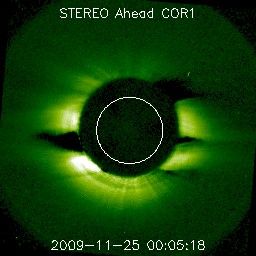 |
| COR1 image from STEREO Ahead showing dark regions caused by an
imprecise background subtraction. These dark regions should be filled
in when the image is
reprocessed after 35 days.
|
Sometimes bright planets get mistakenly folded into the HI1 background
calculations, creating dark "holes" in the data. For example, below is an
image of the planet Venus as seen by HI1-B on September 15, 2009, compared with
an image from a few days later. The computer is subtracting too much scattered
light at the earlier location of Venus.
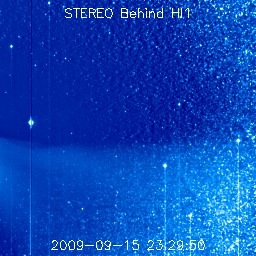 |
|
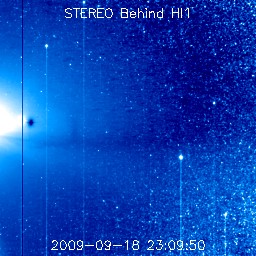 |
| The planets Venus as seen by the
STEREO Behind HI1 telescope on September 15, 2009 |
|
Hole seen 3 days later at previous location of Venus. Venus
itself has moved slightly to the left. |
More discussion is available about a
related artifact
caused by the effect of planets on the background subtraction.
There are also some permanent artifacts in the instrumental backgrounds of the
COR1 telescopes. Since these artifacts are always there, in a perfect world
they would be removed in the background subtraction process. However, they are
sensitive to small moment-by-moment changes in the spacecraft pointing, and
thus cannot be completely removed. The artifacts are demonstrated in the
images below. (Only a few representative artifacts have been circled.) They
are caused by small defects in the field lens of each COR1 telescope, though
some have also appeared since launch due to the migration of individual dust
particles onto the surface of the field lens. Although they can appear
anywhere within the image, they are most visible near the edge of the occulter.
These artifacts appear as bright rings with a dark center, reflecting the shape
of the input aperture with the occulter in the center. Generally, only one
side or edge of the ring is visible, giving the artifact a "fingernail"
appearance.
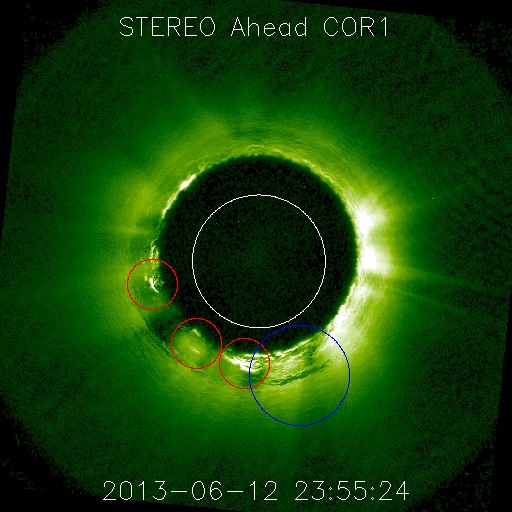 |
|
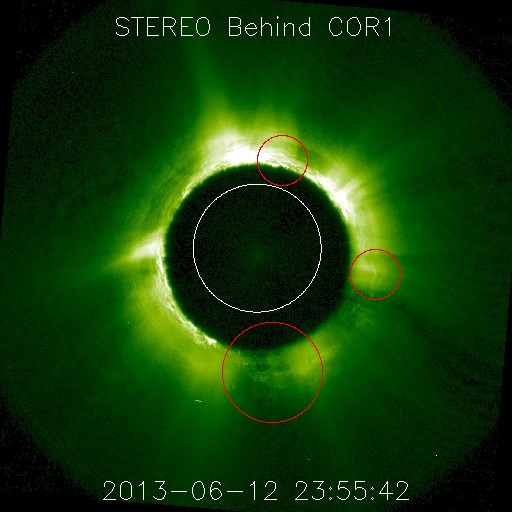 |
| The red circles highlight a few of the image artifacts caused
by defects in the COR1-A field lens. The blue circle highlights dark areas
where image saturation is occurring. Click on the image for a
full-resolution version. |
|
The red circles highlight a few of the image artifacts caused
by defects in the COR1-B field lens. Click on the image for a
full-resolution version. |
The blue circle in the COR1-A image demonstrates a different artifact related
to the instrumental background. The background in the COR1-A telescope has
been slowing increasing over the last several years in the region just below
the occulter due to aging of the instrument. There are now some small areas
where the images are saturated. These appear as dark areas in the
background-subtracted images. Occasional adjustments are made to the COR1-A
exposure time to reduce the area of image saturation.
Back to image artifacts page.
Last Revised: Monday, 05-Aug-2013 20:37:38 UTC
Responsible NASA Official: ![[email address: Therese.A.Kucera<at>nasa<dot>gov]](/img/kucera_email1.jpg)
Accessibility
Privacy Policy and Important Notices
Feedback and comments: webmaster
|